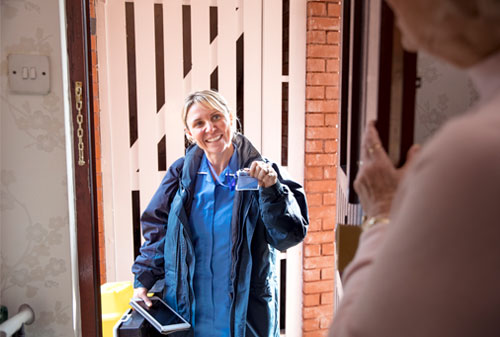




Organisations that provide care must ensure that adequate security is provided.
Care homes face a wide range of security risks that need to be dealt with in order to protect the residents and the equipment in the home.
Residential homes can be large buildings with several points of access and many people visit the homes each day. Some are professionals dealing with the health and welfare of the residents and others can be family members and friends calling in to visit. It would not be difficult for a criminal to gain access without some form of security.
Care homes can also have expensive equipment on site as well as easily stolen items such as televisions and other electrical equipment. Individual’s records also need to be stored safely in the home.
Care homes want to be secure but remain welcoming and homely. Many homes have alarms and CCTV cameras on site. Identification badges for staff and visitors are also common, as well as signing into the environment for fire safety purposes. Access control is also common with at least the main external doors being locked with intercom systems to ensure that only those who are allowed access can enter.
Security could be breached without these systems in place, putting staff, individuals and visitors at risk of harm.
Mae'n rhaid i sefydliadau sy'n darparu gofal sicrhau bod diogelwch digonol yn cael ei ddarparu.
Mae cartrefi gofal yn wynebu amrywiaeth eang o risgiau diogelwch y mae angen ymdrin â nhw er mwyn amddiffyn y preswylwyr a'r cyfarpar yn y cartref.
Gall cartrefi preswyl fod yn adeiladau mawr gyda nifer o bwyntiau mynediad ac mae llawer o bobl yn ymweld â'r cartrefi bob dydd. Mae rhai yn weithwyr proffesiynol sy'n delio ag iechyd a lles y preswylwyr, a gall eraill fod yn aelodau o'r teulu ac yn ffrindiau sy'n galw i mewn i ymweld. Ni fyddai'n anodd i droseddwr gael mynediad heb ryw fath o ddiogelwch.
Gall cartrefi gofal hefyd fod ag offer drud ar y safle yn ogystal ag eitemau hawdd eu dwyn fel setiau teledu ac offer trydanol arall. Mae angen storio cofnodion unigolion yn ddiogel yn y cartref hefyd.
Mae cartrefi gofal am fod yn ddiogel ond parhau i fod yn groesawgar a chartrefol. Mae gan lawer o gartrefi larymau a chamerâu CCTV ar y safle. Mae bathodynnau adnabod ar gyfer staff ac ymwelwyr hefyd yn gyffredin, yn ogystal ac arwyddo i mewn i’r amgylchedd ar gyfer pwrpas diogelwch tân. Mae rheoli mynediad hefyd yn gyffredin, gydag o leiaf y prif ddrysau allanol yn cael eu cloi gyda systemau intercom i sicrhau mai dim ond y rhai a ganiateir sy’n cael mynediad.
Gallai diogelwch gael ei dorri heb i'r systemau hyn fod ar waith, gan roi staff, unigolion ac ymwelwyr mewn perygl o niwed.

Many care staff spend time working alone for some or all of their day.
The Health and Safety Executive (HSE) defines a lone worker as “those who work by themselves without close or direct supervision.” It lists some examples as: people working alone in premises, people who work from home, people working separately from others, people working outside normal hours.
A move towards mobile working, with greater use of technology such as laptops and tablets, and more community-based care means that the numbers working alone have the potential to increase.
There are many potential hazards when working alone including accidents or emergencies arising out of the work and also sudden illness. Staff working alone are more vulnerable to physical and verbal abuse from service users or their families, members of the public or intruders. People working on their own in communities should have a system in place in order for someone to know where they are at all times.
It will often be safe to work alone, however, the law requires employers to consider carefully, and then deal with, any health and safety risks for people working alone.
Employers have a legal duty to have a policy in place to protect lone workers, and a risk assessment must be carried out to minimise any harm. Employers must implement safe systems of work and ‘control measures’ that prevent or reduce the risks identified as part of the risk assessment.
There are a number of strategies that can be put in place to reduce the risks posed to lone workers, however, some have their limitations:
Mae llawer o staff gofal yn treulio amser yn gweithio ar eu pennau eu hunain am rywfaint o’u diwrnod neu eu diwrnod cyfan.
Mae'r Awdurdod Gweithredol Iechyd a Diogelwch (HSE) yn diffinio gweithiwr unigol fel "y rhai sy'n gweithio ar eu pen eu hunain heb oruchwyliaeth agos neu uniongyrchol". Mae'n rhestru rhai enghreifftiau fel: pobl sy'n gweithio ar eu pen eu hunain mewn safle, pobl sy'n gweithio gartref, pobl yn gweithio ar wahân i eraill, pobl sy'n gweithio y tu allan i oriau arferol.
Mae symud tuag at weithio symudol, gyda mwy o ddefnydd o dechnoleg fel gliniaduron a thabledi, a mwy o ofal yn y gymuned yn golygu bod gan y niferoedd sy'n gweithio ar eu pen eu hunain y potensial i gynyddu.
Mae llawer o beryglon posibl wrth weithio ar eich pen eich hun gan gynnwys damweiniau neu argyfyngau sy'n deillio o'r gwaith a salwch sydyn hefyd. Mae staff sy'n gweithio ar eu pen eu hunain yn fwy agored i gamdriniaeth gorfforol a geiriol gan ddefnyddwyr gwasanaeth neu eu teuluoedd, aelodau'r cyhoedd neu dresmaswyr. Dylai pobl sy'n gweithio ar eu liwt eu hunain fod â system ar waith er mwyn i rywun wybod ble maen nhw ar bob adeg.
Yn aml, bydd yn ddiogel i weithio ar eich pen eich hun, ond mae'r gyfraith yn mynnu bod cyflogwyr yn ystyried unrhyw risgiau iechyd a diogelwch i bobl sy'n gweithio ar eu pen eu hunain yn ofalus, ac yna'n delio â nhw.
Mae gan gyflogwyr ddyletswydd gyfreithiol i gael polisi ar waith i amddiffyn gweithwyr unigol, a rhaid cynnal asesiad risg er mwyn lleihau unrhyw niwed. Rhaid i gyflogwyr weithredu systemau gwaith a 'mesurau rheoli' diogel sy'n atal neu'n lleihau'r risgiau a nodwyd fel rhan o'r asesiad risg.
Mae nifer o strategaethau y gellir eu rhoi ar waith i leihau'r risgiau i weithwyr unigol, fodd bynnag, mae gan rai eu cyfyngiadau: